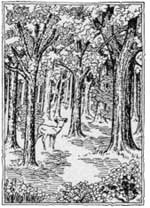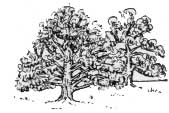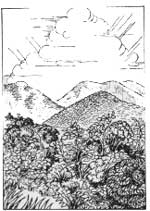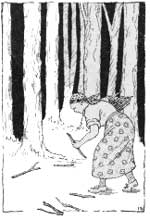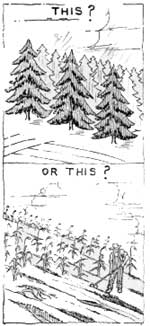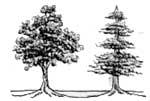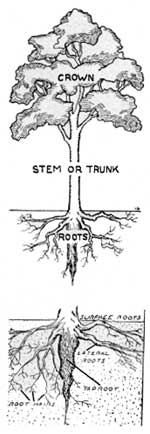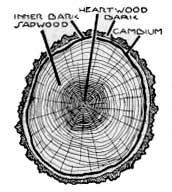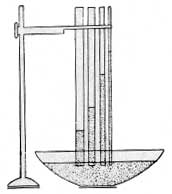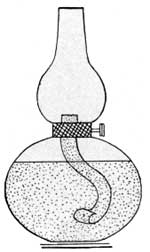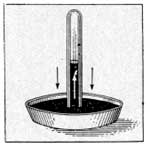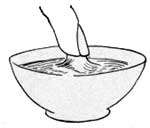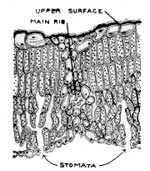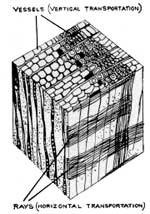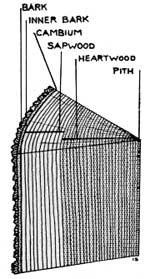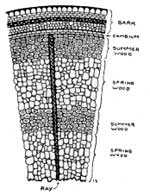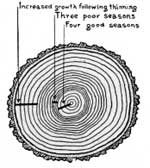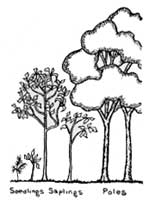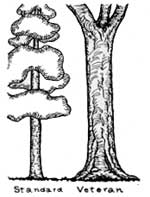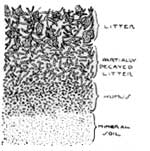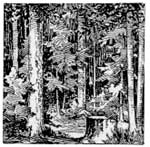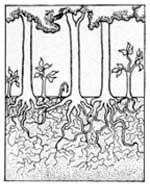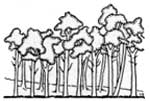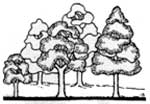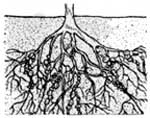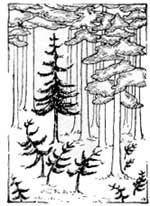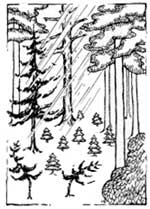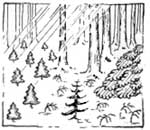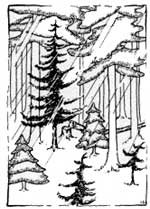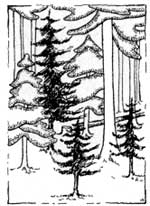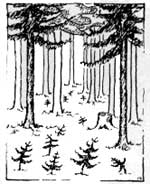|
CCC Forestry
|

|
Chapter 1
INTRODUCTION TO FORESTRY
|
|
||
|
THE WORD "forest" has been variously defined. As men have become better acquainted with the forest and its uses, the definitions have changed. It is difficult to reconcile some of the earlier definitions of the forest as "a waste grounds belonging to the king" (Blackstone), with such modern definitions as "a complex association of trees, shrubs, and other plants in which each individual plays some part in the life of the community" (Graves and Guise). Some foresters recognize management as a factor in the definitions, but forests can and do exist without the slightest semblance of management. To the forester, the forest embraces more than trees and shrubs. It is an association or community of trees, shrubs, soil and soil organisms, animals, birds, and insects, each of which exerts important influences on the ultimate character and value of the area. This association should extend over a considerable area. The farm wood lot of less than 5 acres would not be classified as a forest, although it is possible to practice forestry in it. Trees in the forest usually differ from those grown in the open or in orchards. Their shape and the absence of lower limbs is a result of natural pruning by mutual shading. It is possible to have a number of "wolf" trees in a forest. These low-crowned, wide-spreading individuals do not have typical forest form, but they exist as forest trees. Thus we see that "forest" is a term that cannot be sharply defined. A small tract, called by foresters a wood lot, may be a forest to a city dweller. The easterner may consider the extensive areas of chaparral and manzanita in the Southwest as brushy wastelands, although they are important watershed forests.
For the purpose of this book, let us define the forest as an association of trees (as in large plantations with no undergrowth), or shrubs (as in the watersheds of the Southwest), or both (as in the hardwood and mixed forests), growing on a considerable area, upon which it is possible to practice forestry. |
What Is a Forest?
| |
|
|
||
|
"Forestry" like the term "forest" has been defined in many ways. In Europe the first definitions of forestry laid stress on the ability of the forest and the forester to produce and maintain game for the royal hunt. The old European forester was game keeper and policeman of the hunting preserve. When a scarcity of timber supplies became evident in the Old World and its danger was forecast in America, forestry became the raising of continuous timber crops, and game production was relegated to minor importance. With further study of forests and forest influences, scientists discovered that protection of important watersheds, distribution of precipitation, erosion prevention, and partial control of drying winds were important forest functions. Many forest areas are managed largely with these ends in view, timber production and game management being of secondary consideration. In recent years increased leisure time has created a demand for another forest product which in some areas exceeds all others in importance. This product, not measurable in dollars and cents or in cords or board feet, is recreation. Some definitions of forestry imply that the profession is one to be practiced on nonagricultural land. Forestry may be, and is, practiced on land which, if cleared of trees, would be far better agricultural soil than that on which many farmers are struggling to grow crops of corn or potatoes. Much poor farm land now under cultivation would be better employed raising trees. An ideal plan might be to convert the submarginal land (that which can barely produce an income from farm crops) into forests, and such forested lands as might produce profitable agricultural crops into farms. That ideal situation has not been reached, so forestry is practiced on rich as well as on poor land. Forestry is the production and maintenance of the many and varied products of the forest. It has been defined as a science, but it is a combination of many sciences such as botany, biology, physics, and mathematics. It has been defined also as an art (the application of these sciences). The sciences are fundamentals upon which the art is based. Forestry includes the study of these sciences and their application, which is the art. Hence forestry may be simply defined as the science and art of managing forests so that they yield continuously their maximum of wood products, values, and influences. |
| |
|
|
||
|
A tree is a woody plant exceeding 10 feet in height, with a single stem unbranched for some distance above the ground. Trees live on from year to year, increasing in height and diameter each season. They differ from shrubs in: (a) their manner of branching—shrubs branch at, or close to, the ground; (b) the ultimate height attained—trees commonly reach 180 to 200 feet and occasionally more than 300 feet, shrubs rarely exceed 25 to 30 feet and are usually much smaller; and (c) the shape of their crowns—trees develop crowns characteristic of the species, shrubs with indefinite stem arrangement rarely assume a characteristic form. Certain species, however, such as the sumacs and willows, which are properly classified as trees when growing in favorable locations, may become shrubby under adverse conditions. The tree is composed of three main parts—roots, stem, and crown. Roots extend deep into the soil and anchor the tree against strong winds. They search out the mineral elements and water necessary for maintenance of tree growth. Large roots bear smaller rootlets, and these rootlets in turn bear fine, hairlike roots which absorb the dissolved nutrients from the soil and transfer them to the rootlets, from whence they begin a journey through the roots to the stem. The stem (shaft, trunk, or bole) is a mass of elongated cells or tubes tightly bound together with other smaller cells and shielded against mechanical injury and extreme temperatures by a protective covering of bark. The vital or living mass of tissue in the stem is a thin sheath of active cells, called cambium, separating the bark and wood. Through the tubes of the new wood, inside the cambium, the dissolved food substance passes to the crown. The crown includes the branches, twigs, leaves, and buds. The wood structure of the branches is similar to that of the trunk, the cambium layer and conducting tubes extending to the tips of the smallest twigs. Many theories have been advanced to explain the flow of water and food from the roots to the crown. Early students of plant physiology attributed the ascent of sap to capillary action. Capillarity is the tendency of liquid to rise in fine tubes. If a fine glass tube, open at both ends, is placed upright in a vessel of water, the water level in the tube will be higher than that in the vessel. The smaller the tube, the higher the water will rise. Oil rises in a lamp wick by capillary action; and water will ascend a dry stick if one end is dipped into a vessel of it. The height to which liquid may rise by capillarity is limited, however; it is impossible for sap to reach the crowns of large trees like the redwood and sequoia by capillarity alone. Another force, long thought to be the cause of sap ascension, is atmospheric pressure. As leaves transpire water, according to this theory, a vacuum is created. Atmospheric pressure was thought to force sap upward to fill the void. The action of atmospheric pressure may be observed in the common mercury barometer. The greatest height to which water can be raised by atmospheric pressure is about 32 feet, but sap in trees rises to many times this height. Pressure exerted by the roots has also been credited with causing sap ascent. That root pressure is an active force may be seen when a tree has been cut, especially in the spring—the stump will "bleed." This force also is limited and cannot transport sap to great heights. The most generally accepted explanation of sap ascension is the "cohesion" theory. The column of water in a tree may be likened to a long string. A pull exerted by transpiration (release of water vapor by the leaves) on one end of this string causes movement all along the line to the roots. Energy for this process is supplied by the sun. As the sun evaporates the transpired water, it draws the water column upward to the leaves. Water under such circumstances has a tendency to stay together, or cohere. Cohesion is greater in sap than in pure water. The transpiration pull on the sap is sufficient to move the column to great heights, and the cohesive force of the sap is strong enough to hold the fine columns or "strings" together. Although no one vessel or group of vessels extends the entire length of the tree, there does exist an unbroken series of columns that zig-zag in many directions from the leaves to the roots. Plant physiologists are still seeking explanations of the details involved and the movement of sap is still being investigated. It is probable that all the forces mentioned in this connection contribute to sap ascension. Clearer and more definite conclusions may be obtained by further research. However this may be, by some force or series of forces the sap (water and dissolved nutrients) is carried to the leaves. The leaves are, in effect, small factories where the raw materials are manufactured into food. Each leaf bears many small pores or mouths, called stomata, through which it takes in air. Air is composed of nitrogen and oxygen, with small quantities of argon and carbon dioxide, varying amounts of water vapor, and minute quantities of other elements. Carbon dioxide is separated from the rest of the air by the leaves and is combined, in the presence of sunlight, with water and other elements. Wood is composed chiefly of carbon, oxygen, and hydrogen. The carbon is derived from the air, and the oxygen and hydrogen from the soil water that has ascended to the leaves. Mineral elements from the soil comprise about 1 percent of wood. It is these earthy constituents that remain as ashes when wood is burned. The tree's raw food must be dissolved in water so that it can ascend to the height of the crown, and when the raw materials, including water, are combined with carbon dioxide much unnecessary water remains. This is given off (transpired) through the pores of the leaves and is evaporated by the sun. After manufacture, the elaborated food material returns downward through the cells and tubes of the inner bark, to the twigs, branches, trunk, and roots. The channels of food transportation in a tree may be compared with the blood streams in a human being—blood being carried to the lungs to acquire oxygen, and then flowing to the growing parts of the body. A cross-section of the trunk reveals a series of rings, one for each year of the tree's life. In a large tree the innermost group of rings is dead, hard, brittle, and stiff. The function of this core of heartwood is to maintain the tree in an upright position. Around the heartwood is a sheath of younger wood or sapwood. The sapwood, still alive, helps in the transportation of food and water. Surrounding the sapwood is a fine layer of small cells, called the cambium, which is really the growing portion of the stem. Elaborated food from the leaves travels downward through the inner bark and is diverted laterally into horizontally arranged cell groups or rays. Cambium cells absorb this food substance and grow. Cells increase in number by cell division. A cell grows and splits into two smaller cells; the two small cells grow, and each splits into two more. By cell division and growth, the cambium forms new wood on its inner side and new bark on the outside. The wood growth early in the season (spring-wood) is formed when the trunk must transport vast amounts of water and food; therefore, its cells and tubes are large and thin-walled. The "summerwood" is composed of smaller, heavier-walled cells. This difference in cell structure produces the visible annual rings which can readily be seen on the stump of a tree. It is possible to tell the age of a tree by counting the rings from the center or pith, to the cambium. The tree's history is shown in a cross-section of the trunk—a poor growing season results in a narrow ring, a rich season in a wide one, and fires leave tell-tale scars. Removal of nearby competing trees also is indicated by the wider rings. As the cambium manufactures new wood it increases in size, forcing the bark outward. The older bark, being dead, cannot stretch and expand. Consequently it cracks into the plates, ridges, or scales that are characteristic of some trees. The eucalyptus, or blue gum, sheds its bark annually. The bark of the redwood, on the other hand, remains for years, becoming very thick and ridged before dropping. To perform the functions of growth, the tree must have heat and light in addition to water, minerals, and air. The manufacture of raw food by the leaves requires sunlight. In a dense forest the leaves soon disappear from the shaded understory and the trees develop new ones in the canopy. Some trees are better able to withstand shade than are others. These are known as "tolerant" trees. Beech, hemlock, and balsam fir are examples of tolerant trees, whereas black locust and the larches are intolerant. But no tree can live very long without some sunlight. All growth processes of a tree require energy which is derived from light and heat. Tree growth is negligible in winter. In the extreme North, trees are often stunted and small because their growth is retarded by lack of sufficient heat. According to their sizes, Gifford Pinchot has classified trees into seven groups: 1. Seedlings: Trees of seed origin, up to 3 feet in height. 2. Small saplings: Trees 3 to 10 feet high. 3. Large saplings: Trees more than 10 feet in height, and up to 4 inches in diameter. 4. Small poles: Trees 4 to 8 inches in diameter. 5. Large poles: Trees 8 to 12 inches in diameter. 6. Standards: Trees 1 to 2 feet in diameter. 7. Veterans: Trees more than 2 feet in diameter. |
See Wood Technology, p. 151.
| |
|
|
||
|
The term "forest floor" is often confused with "forest cover." The forest floor is that covering lying close to the mineral soil under the forest. Forest cover includes trees, underbrush, and herbaceous growth. The forest floor resembles a rug in its make-up. It is compact in its lower layers and lighter in its upper layer. It is made up of fallen leaves, twigs, pieces of bark, fruits and nuts, rotting logs, down trees, and other vegetative matter. It consists of both plant and animal life. There are actually three layers of the forest floor. The first one, resting on and merged with the mineral soil, is a mass of humus. It is damp, dark in color, and composed of thoroughly decayed litter (fallen leaves, twigs, and bark). The middle layer is made up of partially decayed litter. The character of the leaves, twigs, and other components may be seen in the compound, and in it animal life and chemical forces are at work reducing this mass to completely disintegrated organic matter which gradually changes into soil. It is humus in the making. The third and topmost layer is exposed to the air. It is made up of newly fallen leaves, twigs, and wood particles. This leafy covering is to the forest floor as the nap is to a rug. Raindrops falling on this cover are checked and broken up, and the run-off enters the spongy soil. When air currents pass through the forest this mass of litter keeps the soil from drying. Bacteria and fungi in the forest litter make decomposition possible. Humus is changed into soil more readily in locations where the seasons are warm and long. On the other hand, where the seasons are short, the litter accumulates in greater quantities and protects the soil and roots from killing freezes. |
| |
|
|
||
|
Trees in the forest are comparable to human beings in a social or economic community, except that the tree's inherent savage struggle for existence is more openly ruthless than man's subtle, diplomatic schemes to get ahead. As there are classes of people in the economic and social scales, so there are classes of trees in the forest community, as follows: Dominant: Overtopping the rest of the stand. Codominant: Beneath the dominant but receiving full sunlight on top and sides of crown. Intermediate: Beneath the codominant, receiving sunlight on top only; growth retarded by dominant and codominant classes. Suppressed: Beneath all other living classes; receiving little or no sunlight; little chance for recovery. Dead: Trees which have succumbed in the struggle. Each tree succeeds in its life struggle only to the extent that the trees in the higher crown classes allow it to succeed. When the larger trees are removed, through death, lumbering, or silvicultural cuttings, the intermediate and suppressed ones have a chance to recover. Some trees, however, cannot reestablish themselves when released from long suppression. The life and death struggle results in a survival of the fittest. On some sites and under certain conditions the fittest tree may be an important timber species. On others it may be a weed for which the lumberman can find no market. The forester attempts, through wise use of the axe (removal of certain trees) and underplanting, to convert the stand to trees of economic value.
Competition for soil nutrients (foods) often results in well developed and widespreading root systems. Competition for light usually develops tall, straight survivors, and that is one of the reasons trees are placed close together in plantations. Such spacing causes the ultimate death of over half the seedlings, but the trees that survive usually are well formed timber trees devoid of large lower limbs. Practically all trees are tender when young, and are susceptible to scorching by direct rays of the sun. Foresters protect such trees by planting them beneath "nurse" trees. The beech with its thin canopy is an excellent nurse tree. It guards against the direct sun rays but permits enough light to filter through to sustain the young trees beneath it. Intolerant trees, that is, trees unable to withstand excessive shade, planted under young beech soon harden and reach for more sunlight, finally overtopping the beech. Some trees—the locust and Scotch pine for examples—add nitrogen to the soil through nodules formed on their roots. Trees like spruce which ordinarily perish on poor, sandy soil may still be grown on such sites if mixed with nitrogen-producing trees. Other trees have poisonous effects. It has been noted that often no vegetation except grass will grow beneath the black walnut. Poisons given off by the roots of black walnut may be fatal to any woody vegetation with which they come in contact. Let us follow the struggle for existence in a forest in its natural state, one in which forestry is not being practiced. We will assume that the forest consists of large white pines and hemlocks. The larger pines have overtopped the hemlocks and are dominant, but beneath their shade the tolerant hemlocks are thriving. As the older pines die and succumb to insects and decay, openings are left in the canopy. Ordinarily a dying tree produces an abundance of seed in its final years. These seeds and those of neighboring trees fall to the ground—to the dense brush-covered areas of laurel and rhododendron, to the open spaces in the shadows of towering pines and hemlocks, and to the sun-lit patches of forest floor vacated by dead trees. Warm rains cause the seed to sprout. Those in the thickets are quickly choked by the brush, those in the shadows die from lack of light, but those in the openings put forth tiny stems and roots. While they are tender and succulent, the seedlings are in constant danger from all the herbivorous animals of the forest. Deer and other browsing animals feed on the new leaves, and birds eat the tender sprouting seed. After the first season, barely half the crop is heft, Where there is no protective leaf canopy, heavy rains gouge the seedlings from their beds, frost kills many more, the scorching rays of the sun burn up their unprotected buds and needles, and brush and weeds compete with them for possession of the openings and for the food elements in the soil. A few of the trees, however, become established in favorable spots. The following spring the older trees burgeon forth, with new shoots and leaves, to fill the holes in the canopy; the shade deepens, and the seedlings begin a new struggle for light, water, and food. As the snow melts, they become exposed once more to the deer and rabbits; and late frosts retard their growth. The closing of the canopy of the older trees allows sufficient light for seedling growth and protects them from the direct rays of the sun. But as the canopy closes more and more each year the shade becomes too intense. Being less tolerant than the hemlock, the young pines yellow and begin to die. If the canopy remains closed, all the young pines will die and the tolerant hemlocks will have full possession of the area. But now a storm blows down a large overmature pine. This permits more light to reach the understory. Responding to the light, many of the young pines recover, and rapidly grow to reach a place in the sun. Growth of the hemlock also is accelerated. All this time numerous insects and diseases are attacking the trees, and an intense competition for soil, water, and food takes place. The weakened trees succumb to these attacks, and the stronger ones take possession of the root and crown space vacated by their dying neighbors. Thus the trees pass through the sapling stage—the intolerant white pines gaining dominance because of their striving for additional light. They are now tall saplings with pointed crowns and straight boles which excess shading has made limbless. Overtopping the hemlocks, however, does not give the pines full possession of the site. The tolerant hemlocks thrive well in the shade; and when the pines settle down to grow in diameter, the hemlocks continue to grow in height. Since pine demands more light than hemlock, successive generations of competition for a site usually result in the complete suppression of the pine. White pine seedlings cannot endure the dense shade of mature pines, but hemlock can establish itself under shade. Although this is the story of but two species, similar struggles go on wherever two or more trees are contending for the same limited area. Shrubby and herbaceous plants enter into the struggle particularly in the earlier stages; insects and diseases are often determining factors in the ultimate plant growth. |
| |
|
|
| |
|
|
||
|
The forest is much more than trees and shrubs. It is a complex association of many forms of life, struggling together and against each other to grow and reproduce. Competition for light and food in the forest usually results in tall, straight trees free of large lower limbs. Often, however, this survival of the fittest does not produce the best timber species or the species best adapted to man's use. Forestry, by applying the knowledge of tree growth, soils, spacing, planting, improvements, and protection to timber production, has directed the forces of nature to fulfill man's needs. The tree is almost as complex as the forest itself. It is a living plant, comparable in many instances to man. Like man, it needs air, light, heat, water, and food for its growth. Its roots penetrate deep into the ground in search of food material; its trunk carries the raw food to the crown where the leaves combine it with elements from the air to form nourishment for the growing cells. Billions of minute cells and tubes make up the substance we know as wood, and each year many more cells are added through the growth of the cambium layer. As the cambium grows it adds a new layer of wood on its inner side and a new layer of bark on its outer side. In the spring the cambium grows large cells with thin walls, but in the summer smaller thicker-walled cells are grown. The difference between the spring and summer wood may readily be seen on a cross-section of the tree trunk; and it is possible, by counting these annual rings, to determine the tree's age, and by examining the size and condition of the rings, to study the tree's history and to predict future growth. The transportation of food material from the roots to the crown is a subject which has long interested scientists. Many explanations have been attempted but the most generally accepted one is the "cohesion theory" which likens the columns of sap to a series of strings pulled upward by the sun's power to evaporate moisture transpired, or given off, by the leaves. One of the important components of the forest is the forest floor (the soil, humus, and litter). It is from this source that the tree receives most of its food. In cross section the forest floor appears as a number of intermingling layers of leaves, twigs, and other litter in various stages of decomposition, resting upon and merging with the mineral soil. Bacteria and minute insects live in the soil layers and hasten the disintegration of litter into rich soil. The forest floor acts as a huge sponge in absorbing rainfall and snow melt, retaining some of it for plant use but permitting most of it to trickle slowly into springs and streams to maintain constant flow. Tree roots in the forest floor compete for water and food, while their trunks and crowns struggle for light. Consequently different classes of trees appear. Those seed which have been fortunate in falling in open spaces or on good soil thrive and grow into healthy trees; others, less fortunate, fight a losing battle against natural forces. Some trees are endowed with power to resist shade and will live on year after year in the shadows of towering neighbors. Grazing animals eat or trample young seedlings, insects and diseases maintain a constant attack so that only a small percentage of the seeds which reach good soil finally become timber producers. |
| |
| <<< Previous | <<< Contents>>> | Next >>> |
|
ccc-forestry/chap1.htm Last Updated: 02-Apr-2009 |

